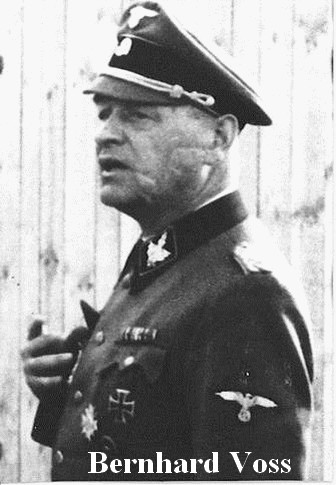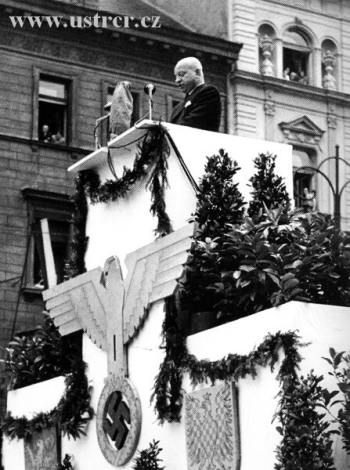Zajímavé čtení
SVATOVÁCLAVSKÁ DOBROVOLNICÁ ROTA (SDR) - Freiwillige St. Wenzels-Rotte
Categories: Wars
The year was 1945, the war was slowly coming to an end and the days of the Third Reich were numbered. In spite of all the facts that predicted the Nazis' defeat, there were fanatics in their ranks who did not want to admit reality and invented ways to avert that unhappy end...
The establishment of the St. Wenceslas Volunteer Company with the approval of K. H. Frank on March 5, 1945. It was a purely Czech volunteer unit, which was to be deployed against the advancing Soviet army within the Waffen SS. Recruitment was mainly in the ranks of the League Against Bolshevism and in the then ProtectorateThe members of this body were appointed by the Protectorate government on 28. May 1942, all youngsters of Aryan origin between the ages of 10 and 18 were obliged to attend. The recruitment was led by a member of the curatorium's management, Karel Michalíček, and took place both in Prague and in rural districts.
Around 21 March, the first group of fifty volunteers was taken to the training centre in Čeperka near Unhoště. Another thirty adepts joined in mid-April.
K. H. Frank and Teuner was completely different, they counted on at least 1000 men. They were not interested in such small units, which was especially evident in the supply. The volunteers trained only with rifles and bayonets. The heaviest weapon at their disposal was the machine gun. Instead of SS instructors, a Wehrmacht lieutenant Beywl was in charge of the training. He imparted to his charges a wealth of wartime experience. One hour a day was set aside by the Czech commander of the St. Wenceslas Company, Eduard Chalupy, to teach Nazi worldview. Other factors in the company's insignificance included clothing; instead of SS uniforms, volunteers wore dark blue sweatpants and zip-up jackets. All that remained of the SS equipment were camouflage blouses and high boots. Instead of SS rations, they received only herring and potatoes for lunch.

All the while, the department has been burdened by a lack of time. Originally, three months were to be set aside for training. This duration was set during negotiations in March 1945 by SS-Brigadeführer Bernhard Voss, who was involved in the crackdown on Czech students in November 1939 and also in the Ruzhin executions of students.
However, the reality was completely different, the volunteers had not even gone through basic training. The May Uprising broke out and at that time the unit consisted of 77 men who had never been involved in the fighting. Before they could use their knowledge from the training, revolutionary insurgents from Kladno arrived at the Čepelka Hotel. It was obvious that they were on the safe side and knew exactly who the young men dressed in the uniform of the Kuratorium really were. The Company had no choice but to surrender. The detained members of the unit, including the commander Eduard Chalupa, ended up in the internment camp in Unhošt'.

From the beginning, there were voices of disdain for the St. Wenceslas Volunteer Company among the Nazi leaders of the time.
I will mention to all of them the then Minister of Education and Popular Enlightenment, Emanuel Moravec, who is said to have declared.It's nothing! We need our own SS units."
But what was the real reason for the establishment of this unit? Hitler himself would probably not have agreed to such a move at all: he considered direct participation in combat to be an honour, and that is not something that belongs to the hated Czechs. The possibility that, after the Red Army had occupied Bohemia and Moravia, the members of the Czech collaborationist formation would form a band of saboteurs in the rear of the army is a possibility. However, this did not happen and the idea of subverting the enemy army remained buried for ever.
You can search for artefacts from this period using our metal detectors
Footnote by Elmara
The question of the origin of the "Czech" SS units is still rather mythological to this day. Very often in the literature the division "Bohmen und Maren" appears, but it never officially received this name and, most importantly, its members were not of Czech origin. The division should have been named after the place of its last battles.
Members of the infamous Protectorate Curatorium, headed by Emanuel Moravec, tried for a long time to convince the Germans of the possibility of creating Czech Wafen SS units. The dream, and the first division, was to become St. Vencl. However, the attitude of the German government towards the possibility of deploying Czech soldiers remained unchanged throughout the war (it was consistently negative, and Adolf Hitler's famous statements that no Czech mother would shed tears for her sons in this war, etc.).
And so, apart from the exceptional actions of the Czech government troops in Italy, which ended in the expected fiasco for the Germans (soldiers defecting to the partisans, passing messages, etc.), no Czech unit took part in the fighting alongside the Germans.
(if you want to add anything to this topic (information, photos, etc.) please write to klub@lovecpokladu.cz
Cílek, R.: The Protectorate: the last act or FESTUNG BÖHMEN
Borovička, M.: KOLABORANTI
www.svet.czsk.net, www.obrys-kmen.cz, www.kcprymarov.estranky.cz, www.militaria.cz
The article is included in categories:
Post
Pravdou je, že snad jediným kovaným Čechem, jenž sloužil v SS byl zřejmě syn Emanuela Moravce Igor, který v hodnosti SS- Oberjunkera na konci války velel samostatné minometné četě, jenž odrážela sovětské útoky na východní frontě v Prusku.
TO lons : Pokud bereš čechy z tehdejšího protektorátu tak určitě ano :) Pokud se ale podíváš třeba na Hlučínsko, kde obyvatelstvo dostalo novou národnost "Slezkou". Je to najednou všechno jinak. Tam se najdou na půdách takové věci, že oko válkaře pro slzy nevidí :)
Přihlásit se k nim v březnu 1945 to už chtělo pořádné nadšení 
pěkný článek, díky
je pravdou, že AH nechtěl na své straně české jednotky (i když kolaborujících dobrovolníků by se jistě hlavně v počátečních fázích ww2 našlo nemálo), protože očekával ránu dýkou do zad (s odkazem na legionářské tradice čs. branné moci).
A tak jsme se po válce mohli púrsit, že jsme spolu s Poláky byli jediným národem, který se neposkvrnil účastí na nacistickém tažení Evropou.
Pokud jde o hlučínské, mám ten dojem, že těm se již za dob RU říkalo "Prajzi" a po 38. měli tu pochybnou čest stát se coby volksdeutschové součástí německé Wehrmacht (a ti uvědomělí samozřejmě i jiných formací).
Pro zajímavost když už tady byla řeč i slovenských jednotkách tak část nadbytečné pohotovostní jednotky ( 50 důstojníků HG+ asi 50 členů z Domobrany +další ) byla převelena těsně před kv.povstáním v Praze z Olomouce do kasáren Lešany (dnes Vojenské muzeum)kde se znich sestavil pluk o 2 oddílech. Měli se účastnit potlačování povstání v Praze , ale náč. gen. štábu Otomar Kubala toto nasazení všemožně bojkotoval protože se obávali v případě boj. nasazení tvrdých represí této jednotky po válce.Pro zajímavost , těsně po válce se našla v jednom sklepě plukovní pokladna kde byl 1500000 Sk. Čeští vojáci je spálili v domění , že už neplatí leč tyto s. koruny ještě v té době platily.Tyto poznáky jsou z výpovědi O. Kubaly u soudu v Bratislavě v roce 1948 a o té kase ( trezoru) z ústního podání jednoho velitele pluku nebo brigády v Lešanech který u toho byl.
no vzhledem k tomu ,že bydlím kousek od Hlučína a skoro rok jsem tam žil,můžu říct ,že místní lidi žijí jakousi euforií a hrdostí a vychvalováním sama sebe ohledně předků.Ale to vše je jen pozlátko na jejich současném chování,kde již těžko najdete ty pravé prajzáky/Alteschule/.Takže,když to shrnu,tak rovnou zapomeňte na nějaké půdovky a už vůbec nečekejte jejich vstřícnost,spíše si zajděte do místních lesů  .
.
















